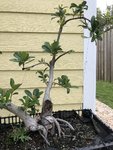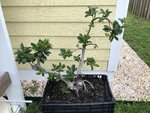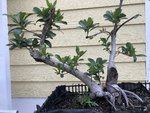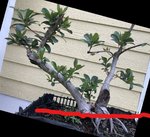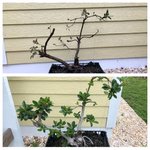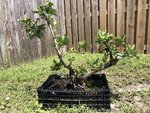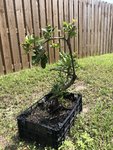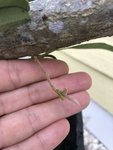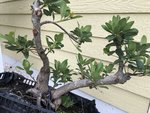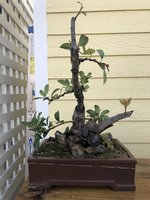I have a few thoughts.
1. - I would rotate the pot 180 degrees. Lets get a good photo from the back. Reason is, normally you want the trunk(s) leaning slightly toward the viewer. It is a design technique that creates the illusion of a taller tree, gives one the sense that they are looking up into a tall tree. Viewed as "more friendly" rather than "shying away". Japanese might say the tree "bows to the viewer". Now it is not an absolute rule, but when in doubt, I have found following design conventions usually leads to more attractive tree. If you really like seeing the tree from this side, experiment by propping the pot up at different angles, see if propped up so the right hand trunk leans toward the viewer looks better.
2 - Similarly - experiment with tilting the pair to the right maybe another 15 degrees. Photo attached is tilted to right exactly 15 degrees. I might go a little more, but when tilted to 30 degrees, that was too far, made the 'V' symmetrical, which should be avoided for other visual design rules.
When you repot, bury the nebari deeper, at least as deep as the red line. This way new surface roots will form on the tops of the ugly roots and eventually yield an interesting, not completely radial nebari.
The "classical ideal" bonsai has a perfectly symmetrical, radial nebari, where the roots come off the tree like spokes of a bicycle wheel. Some really like it, some find it too stylized. Actually, it is quite difficult to achieve such a nebari. But a consistent beginner mistake is to expose the root system, expose the nebari too early in a tree's development. The nebari is something you look at while repotting, but then bury at least 1/4 to 1/2 inch deep until the tree is in late stages of development. Only when a tree is near exhibition ready do you expose the nebari. Even though every time you repot you look at it, cut off crossing roots and otherwise train the roots every time you repot, then bury it until the tree is really ready for exhibition. Exposing a nebari will result in a tree that sits on a "volcano" shaped cone of roots with gaps and spaces where there should be roots to fill in. Once the "volcano of roots" forms, it takes many years to correct. Bury the roots now, and the problem won't form, or won't get worse, in the case of this tree.

